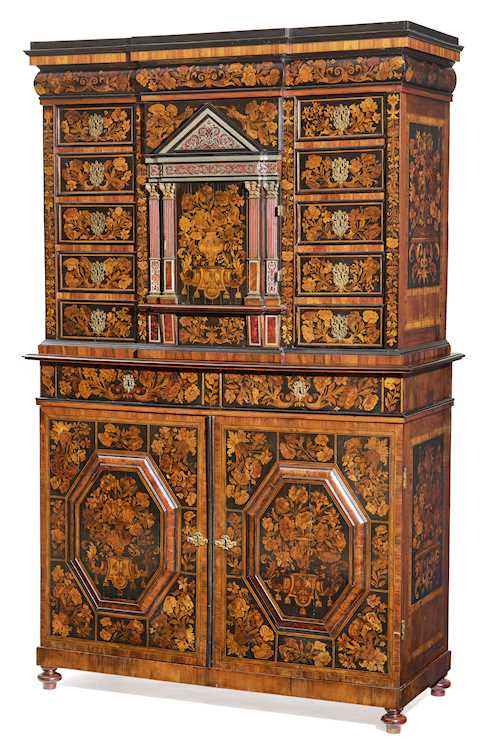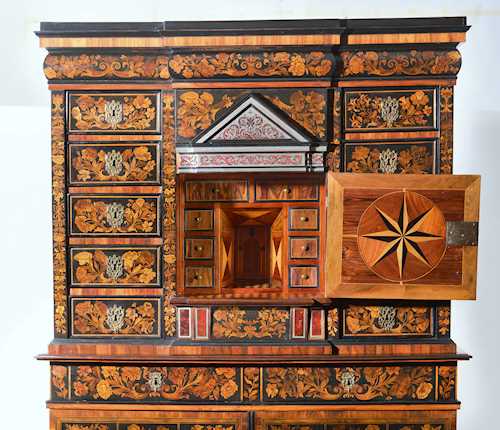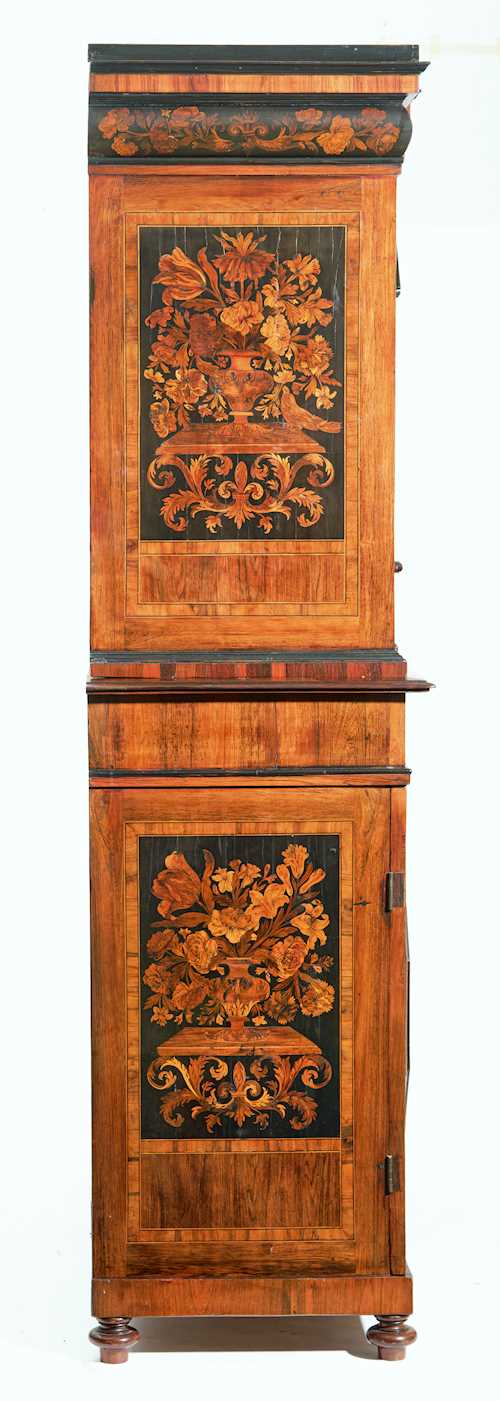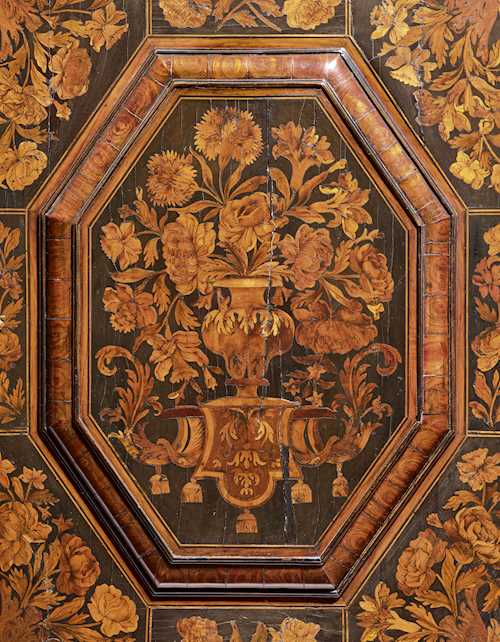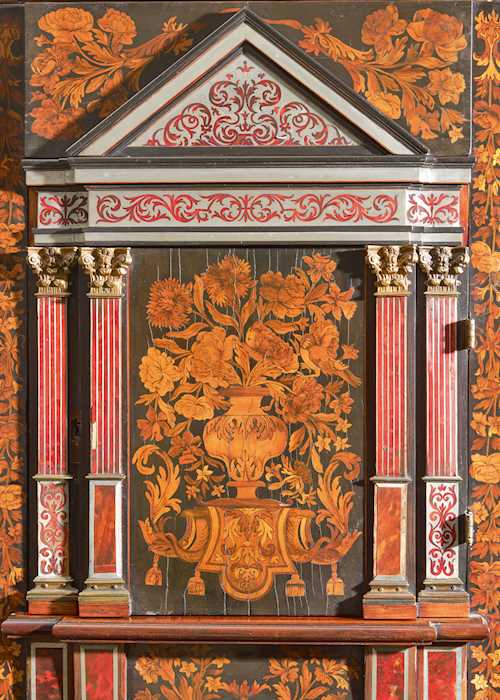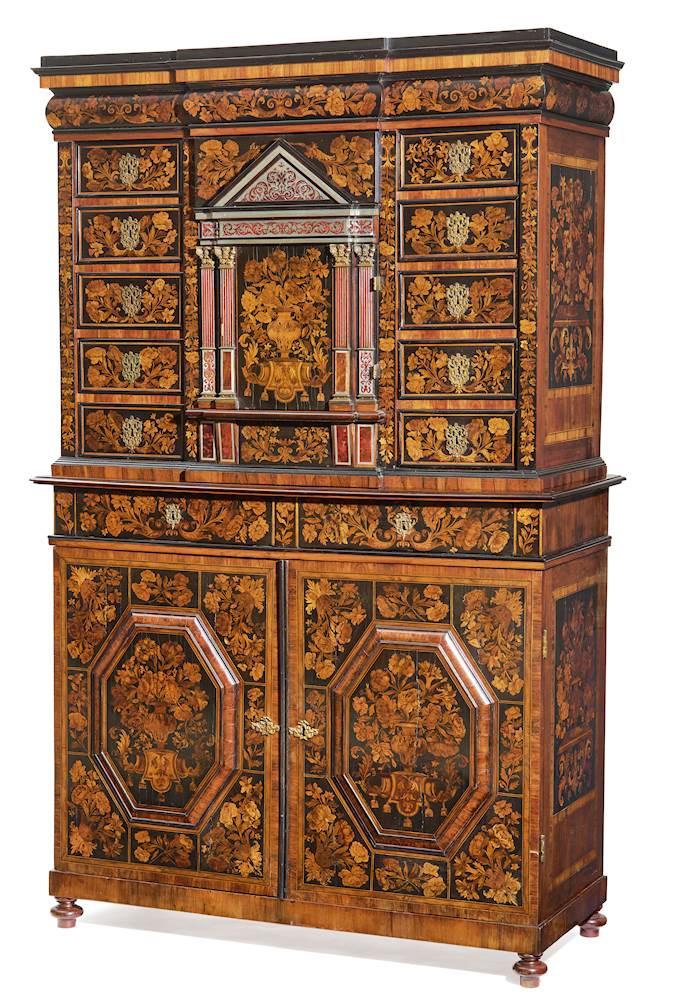
拍品 1058 ♣ - A210 家具、瓷器&银器 - Donnerstag, 19. September 2024, 02.00 PM
RICHLY INLAID DEUX-CORPS CABINET
Louis XIV, probably Chambéry or Grenoble, late 17th century. In the manner of Noël Hache (1630-1675) or Thomas Hache (1664-1747) or Dutch work, late 17th century. In the manner of Jan van Mekeren (1658-1733).
Walnut, rosewood and other partly tinted and fire-shaded woods inlaid with flower bouquets, vases, garlands, birds and leaves. Rectangular body with straight, stepped and cambered cornice on a straight plinth and round feet (probably later). Architecturally structured front. The upper section with twelve drawers arranged around a central door designed as a temple between double pilasters, with red and brown tortoiseshell and pewter marquetry. The central door opening onto eight drawers and a compartment. The lower section with two drawers above double doors with bastion-shaped panels. Bronze mounts. Inscribed and dated 7.3.39 Dr. Staehelin-Paravicini / Basler Droschkenanstalt Settelen Möbel Lagerhaus on the back with an old label. 6 keys.
133 × 55 × 211 cm.
含有象牙、犀牛角及/或其他瀕危或受保護物種物質的拍賣品,在本目錄中特別註有♣符號。一些國家禁止或限制進口或出口含有象牙、犀牛角及/或源於其他瀕危或受保護物種的物品。因此,若您拍賣購得標有♣的物品,並擬運往其他國家,您應在拍賣前了解及遵守所有相關海關的規則及法規。
Chips to the pewter marquetry and the tortoiseshell. Fitted interior probably removed later. Cracks and small losses to the marquetry. Repairs. Fittings partly later.
Provenance:
- Private collection Dr. August Staehelin-Paravicini (1871-1959), Basel, at least until 3 May 1940.
- In family ownership in Basel through inheritance.
We would like to thank Settelen AG for confirming that this piece of furniture was stored in Basel by its former owner Dr. August Staehelin-Paravicini from March 7, 1939 to May 3, 1940. Dr. August Staehelin-Paravicini came from an old family established in Basel, was an ophthalmologist and passionate art collector as well as the author of the inventory of cut glass in Switzerland published in 1926.
The attribution to a specific ebenist or the geographical classification is difficult, as the use of such inlay work is typical of the Hache dynasty of ebenists from Calais and the Dutch ebenist Jan van Mekeren. After traveling extensively in France, Noël Hache settled in Toulouse ca. 1656. His origins suggest that he may have adopted the techniques of the Flemish maître, making it difficult to distinguish him from Dutch ebenists. Noël Hache was probably the only person in Toulouse at the time to make furniture from ebony veneer while keeping up with the latest fashions and innovations of the Parisian workshops. His son, Thomas Hache, was eleven years old when his father died, but it can be assumed that he inherited the technique of inlaying lifelike flowers from his father. Our cabinet is also reminiscent of Dutch works by Jan van Mekeren (see Rijksmuseum, inv. no. BK-1964-12), who worked in London, in its choice of floral marquetry and its formal language. A pair of double-door cabinets from the Mentmore auction of May 1977 was attributed to Jan van Mekeren and shows very similar design features to the substructure of the cabinet on offer, namely the striking octagonal bossing and the choice of similar floral bouquets (see Sotheby's Mentmore auction, Vol. I, May 18, 1977, lot 914).
Literature:
- Pierre and Françoise Rouge: Le Génie des Haches. Dijon 2005.
- René Fonvieille: La Dynastie des Haches. Grenoble 1974.
Provenance:
- Private collection Dr. August Staehelin-Paravicini (1871-1959), Basel, at least until 3 May 1940.
- In family ownership in Basel through inheritance.
We would like to thank Settelen AG for confirming that this piece of furniture was stored in Basel by its former owner Dr. August Staehelin-Paravicini from March 7, 1939 to May 3, 1940. Dr. August Staehelin-Paravicini came from an old family established in Basel, was an ophthalmologist and passionate art collector as well as the author of the inventory of cut glass in Switzerland published in 1926.
The attribution to a specific ebenist or the geographical classification is difficult, as the use of such inlay work is typical of the Hache dynasty of ebenists from Calais and the Dutch ebenist Jan van Mekeren. After traveling extensively in France, Noël Hache settled in Toulouse ca. 1656. His origins suggest that he may have adopted the techniques of the Flemish maître, making it difficult to distinguish him from Dutch ebenists. Noël Hache was probably the only person in Toulouse at the time to make furniture from ebony veneer while keeping up with the latest fashions and innovations of the Parisian workshops. His son, Thomas Hache, was eleven years old when his father died, but it can be assumed that he inherited the technique of inlaying lifelike flowers from his father. Our cabinet is also reminiscent of Dutch works by Jan van Mekeren (see Rijksmuseum, inv. no. BK-1964-12), who worked in London, in its choice of floral marquetry and its formal language. A pair of double-door cabinets from the Mentmore auction of May 1977 was attributed to Jan van Mekeren and shows very similar design features to the substructure of the cabinet on offer, namely the striking octagonal bossing and the choice of similar floral bouquets (see Sotheby's Mentmore auction, Vol. I, May 18, 1977, lot 914).
Literature:
- Pierre and Françoise Rouge: Le Génie des Haches. Dijon 2005.
- René Fonvieille: La Dynastie des Haches. Grenoble 1974.
CHF 12 000 / 18 000 | (€ 12 370 / 18 560)

